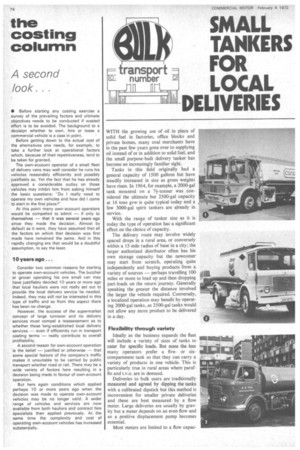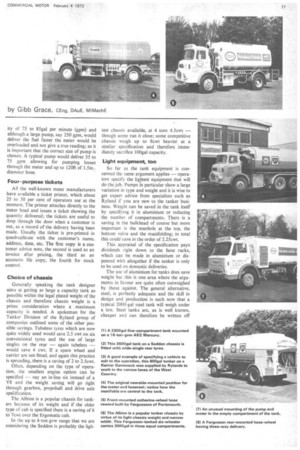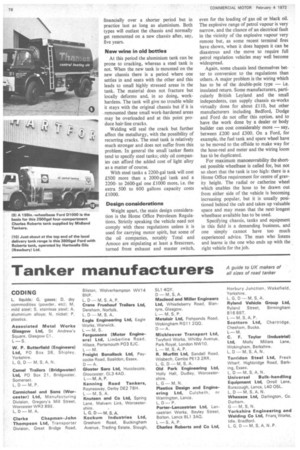SMALL TANKERS FOR LOCAL DELIVERIES
Page 80

Page 81

Page 82

If you've noticed an error in this article please click here to report it so we can fix it.
WITH the growing use of oil in place of solid fuel in factories, office blocks and private homes, many coal merchants have in the past few years gone over to supplying oil instead of or in addition to solid fuel, and the small purpose-built delivery tanker has become an increasingly familiar sight.
Tanks in this field originally had a general capacity of 1500 gallons but have steadily increased in size as gross weights have risen. In 1964, for example, a 2000-gal tank mounted on a 74-tonner was considered the ultimate but 2500-gal capacity at 16 tons gvw is quite typical today and a few 3000-gal spirit tankers are already in service.
With the range of tanker size as it is today the type of operation has a significant effect on the choice of capacity.
The delivery route may involve widely spaced drops in a rural area, or conversely within a 15-mile radius of base in a city; the larger authorized distributor often has his own storage capacity but the newcomer may start from scratch, operating quite independently and buying products from a variety of sources — perhaps travelling 100 miles or more to load up and then dropping part-loads on the return journey. Generally speaking the greater the distance involved the larger the vehicle required. Conversely, a localized operation may benefit by operating 2000-gal tanks, as 2500-gal tanks would not allow any more product to be delivered in a day.
Flexibility through variety Ideally as the business expands the fleet will include a variety of sizes of tanks to cater for specific loads. But none the less many operators prefer a fiveor sixcompartment tank so that they can carry a variety of products in one vehicle. This is particularly true in rural areas where paraffin and t.v.o. are in demand.
Deliveries to bulk users are traditionally measured and agreed by dipping the tanks with a calibrated dipstick but this method is inconvenient for smaller private deliveries and these are best measured by a flow meter. Large deliveries are usually by gravity but a meter depends on an even flow and so a positive displacement pump becomes essential.
Most meters are limited to a flow capac ity of 75 to 85ga1 per minute (gpm) and although a large pump, say 250 gpm, would deliver the fuel faster the meter would be overloaded and not give a true reading; so it is important that the correct size of pump is chosen. A typical pump would deliver 55 to 75 gpm allowing for pumping losses through the meter and up to 120ft of 1.5in.diameter hose.
Four-purpose tickets
All the well-known meter manufacturers have available a ticket printer, which about 25 to 30 per cent of operators use at the moment. The printer attaches directly to the meter head and issues a ticket showing the quantity delivered: the tickets are useful to drop through the door when a customer is out, as a record of the delivery having been made. Usually the ticket is pre-printed in quadruplicate with the customer's name, address, date, etc. The first copy is a customer advice note, the second is used as an invoice after pricing, the third as an accounts file copy, the fourth for stock control.
Choice of chassis Generally speaking the tank designer aims at getting as large a capacity tank as possible within the legal plated weight of the chassis and therefore chassis weight is a prime consideration where a maximum capacity is needed. A spokeman for the Tanker Division of the Ryland group of companies outlined some of the other possible savings. Tubeless tyres which are now quite widely used would save 2.5 cwt on six conventional tyres and the use of large singles on the rear — again tubeless — would save 4 cwt. If a spare wheel and carrier are not fitted, and again this practice is spreading, there is a saving of 2 to 2.5cvvt.
Often, depending on the type of operation, the smallest engine option can be specified -say an in-line six instead of a V8 and the weight saving will go right through gearbox, propshaft and drive axle speCification.
The Albion is a popular chassis for tankers because of its weight and if the older type of cab is specified there is a saving of 6 to 7cwt over the Ergomatic cab.
In the up to 6-ton-gvw range that we are considering the Seddon is probably the ugh
test chassis available, at 4 tons 4.5cwt — though some run it close; some competitive chassis weigh up to 8cwt heavier at a similar specification and therefore immediately sacrifice 100gal capacity.
Light equipment, too So far as the tank equipment is concerned the same argument applies — operators specify the lightest equipment that will do the job. Pumps n particular show a large variation in type and weight and it is wise to get expert advice from specialists such as Ryland if you are new to the tanker business. Weight can be saved in the tank itself by specifying it in aluminium or reducing the number of compartments. There is a saving in the bulkhead of course but more important is the manhole at the top, the bottom valve and the manifolding; in total this could save in the order of 2.25cwt.
This appraisal of the specification pays dividends right down to the hose racks, which can be made in aluminium or dispensed with altogether if the tanker is only to be used on domestic deliveries.
The use of aluminium for tanks does save weight but this is one area where the arguments in favour are quite often outweighed by those against. The general alternative, steel, is perfectly adequate and the skill in design and production is such now that a typical 2000-gal steel tank will weigh under a ton. Steel tanks are, as is well known, cheaper and can therefore be written off financially over a shorter period but in practice last as long as aluminium. Both types will outlast the chassis and normally get remounted on a new chassis after, say, five years.
New wine in old bottles At this period the aluminium tank can be prone to cracking, whereas a steel tank is not. When the new tank is•rnounted on the new chassis there is a period where one settles in and seats with the other and this leads to small highly stressed areas in the tank. The material does not fracture but locally deforms and, in so doing, workhardens. The tank will give no trouble while it stays with the original chassis but if it is remounted these small work-hardened areas may be overloaded and at this point produce hair-line cracks.
Welding will seal the crack but further affect the metallurgy, with the possibility of recurring cracks. The steel tank is relatively much stronger and does not suffer from this problem. In general the small anker fleets tend to specify steel tanks; ohly oil companies can afford the added cost of light alloy as a matter of course.
With steel tanks a 2200-gal tank will cost £500 more than a 2000-gal -tank and a 2200to 2600-gal one £1000 more, i.e. the extra 500 to 600 gallons capacity costs £1000.
Design considerations Weight apart, the main design consideration is the Home Office Petroleum Regulations. Strictly speaking the vehicle need not comply with these regulations unless it is used for carrying motor spirit, but some of the oil companies, notably Total and Amoco are stipulating at least a firescreen, turned front exhaust and master switch, even for the loading of gas oil or black oil. The explosive range of petrol vapour is very narrow, and the chance of an electrical fault in the vicinity of the explosive vapour very remote but, as some recent terminal fires have shown, when it does happen it can be disastrous and the move to require full petrol regulation vehicles may well become widespread.
Again, some chassis lend themselves better to conversion to the regulations than others. A major problem is the wiring which has to be of the double-pole type — i.e. insulated return. Some manufacturers, particularly British Leyland and the small independents, can supply chassis ex-works virtually done for about £110, but other manufacturers including Bedford, Dodge and Ford do not offer this option, and to have the work done by a dealer or body builder can cost considerably more — say, between £200 and £300. On a Ford, for example, the fuel tank and spare wheel have to be moved to the offside to make way for the hose-reel and meter and the wiring loom has tO be duplicated.
For maximum manoeuvrability the shortest possible wheelbase is called for, but not so short that the tank is too high: there is a Home Office requirement for centre of gravity height. The radial or catherine wheel which enables the hose to be drawn out from either side of the vehicle is becoming increasing popular, but it is usually positioned behind the cab and takes up valuable space and may mean that the next longest wheelbase available has to be used.
Specifying chassis, tanks and equipment in this field is a demanding business, and one simply cannot have too much experienced advice. The man who listens and learns is the one who ends up with the right vehicle for the job.














































































































































